Chapter 3
Your Supply Closet
In This Chapter
• Where to store your tools and supplies for home repairs
• Which supplies solve different repair dilemmas
• The subtle differences between fasteners
• The importance of leftovers (the home repair kind)
There are a couple of rules about household repair problems and the supplies that fix them:
1. Repair emergencies usually happen at night, or on weekends and holidays when it’s hard to find someone to help you.
2. A few inexpensive supplies can save a lot of money and grief.
If you can impress upon yourself that bad stuff will happen to your house at the worst possible times, you will not be stuck, as I was, trying to stop a leaky pipe with my finger while being told by my plumber’s answering service that he wouldn’t be back for a week. I had an infant and a 3-year-old, and had to shut off the water to the whole house while the kids and I drove to the home center at 9 P.M. for emergency repair supplies. Of course, my husband was out of town!
DIY Depot: Storing Your Repair Stuff
All the tools and materials in the world are worthless if you can’t put your hands on the right item when you need it.
Lots of handy gentlemen and ladies dedicate a corner of their spotless garage to a workbench and storage area, but maybe you’re not lucky enough to have such a clean corner, or even a garage.
A closet shelf, a cleared cabinet—any place you can get to easily, but also close off and make child- and pet-proof, if these wonderful creatures share your home with you, is fine for storage.

Ounce of Prevention
You do not want your children playing with grown-up tools, tampering with sharp objects like nails and screws, or investigating the contents of bottles of adhesives or cans of lubricants. Whatever place you choose for your repair tools and supplies, make sure it’s out of the reach of children and pets. If not, secure the door of your supply storage area with a keyed or combination lock.
The Supply Side
As your home repair savvy grows, you’ll be doing more jobs and adding to your supply cabinet. But for starters, here are some basic supplies to keep on hand.
Keep It Moving: Lubricants
The places where parts come together often need a bit of help to move smoothly and quietly, or to get unstuck when they haven’t been moved in a while.
A spray or liquid lubricant can help when you’ve got a noisy hinge, a draggy sliding door, or a nut that just won’t turn when you’re trying to loosen it. WD-40 is a popular brand of lubricant that comes in a can; it has a narrow straw that attaches to its sprayer so that you can direct a stream of lubricant to a precise location.
Lubricants are useful for hundreds of chores and repairs. Special lubricants that contain a high percentage of silicon are often helpful for moving parts made of wood, vinyl, or rubber. See Appendix B for more helpful information.
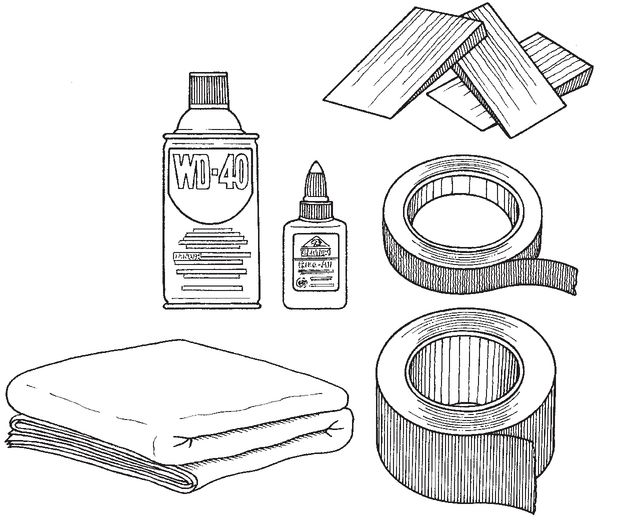
Repair supplies.
Keep It Together: Adhesives
While there are many varieties of adhesive—for every kind of material that can break or fall apart—you can start with a single basic type. White glue, available in supermarkets, stationery stores—virtually everywhere—is good for sticking together paper, cardboard, wood, leather, cloth, and lots of other materials. Keep a container in your supply closet. Keep in mind, however, that it’s not waterproof; you’ll need a different adhesive when water resistance is required.
When you start working with wood, add a container of carpenter’s (wood) glue, which is usually yellow and of the same consistency as white glue.
Specialized adhesives—instant glue or contact cement, for example—are powerful products that create an incredibly tough and virtually instantaneous bond. If you use them, follow directions carefully, and keep the appropriate solvent on hand in case you stick your fingers together!
Blue painter’s tape, like the familiar off-white masking tape, is a light-duty adhesive tape that is easy to apply and remove. The blue variety is called painter’s tape because its adhesive is formulated to lift off a surface without damaging a new coat of paint; regular masking tape can be difficult to remove because it makes a tighter bond, and will often lift off the new paint, shred, or leave a residue if it’s left on a surface too long. The blue stuff is good for holding many lightweight objects in place temporarily.
Duct tape—most people know the gray or silver-colored variety—has a strong adhesive backing because its original use was to seal gaps in lengths of flexible ductwork. (This is no longer an approved use in most building codes.) People have found thousands of uses for duct tape, and written books about it, but it’s an emergency fix for a lot of breaks and tears in household objects: patching a small hole in window glass until you can replace the pane; holding two pieces of wood together while you screw or nail them. Having it in your supply closet will definitely prove handy at some point.
Fill the Gap
Small shims are little wedges of soft wood, usually cedar, that look like miniature shingles. They’re useful for closing gaps between stair treads and risers, for example—you’ll see them used in some repairs in Chapter 7.
They’re also good to level out a table, couch, or chairs when your floors are uneven—just slide a couple under the wobbly leg. While pieces of corrugated cardboard will work as shims in a pinch, a package of these little wooden helpers is cheap; if you’ve got an older home, I guarantee you’ll find uses for them.
Cover It Up
Adrop cloth is essential for protecting the areas of your home where you’re doing a repair. Many people use plastic drop cloths; they’re cheap and disposable. But they’re also slippery to walk on, and some are so thin that they tear with little provocation. Buy a 9’×12’ canvas model and you can shake it out, fold it easily, even wash it when it gets too soiled.
Rub It Off: Abrasives
Get at least one sanding block with a combination of surfaces—a medium-grade grit (80-100) side and a finer grit (120-150) is a nice toolbox standby. It’s easier to handle than sheets of sandpaper. 220-grit sandpaper or blocks are good for fine surface work such as touch-ups to floors and furniture.
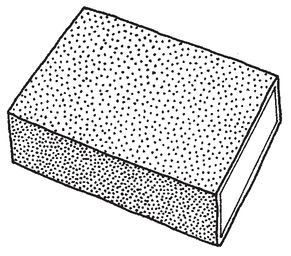
Sanding block.
Eventually, you may also want to get some files: a metal file and a wood rasp for quickly filing edges of these materials.
More Togetherness: A Quick Guide to Fasteners
A variety of fasteners for joining house parts and hanging accessories is good to keep on hand. Invariably if you have a giant coffee can full of wood screws, what you’ll need are a couple of brads. Fasteners are generally inexpensive bits of metal, so a good supply won’t set you back more than a few dollars.
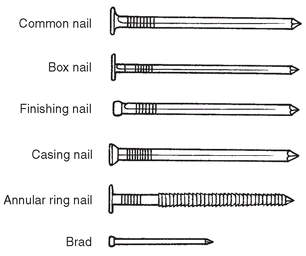
An assortment of practical fasteners.
Screws.
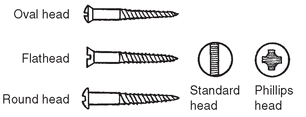
Common nails and their more slender brothers, box nails, are good for general use. They have fairly large heads and good holding power; coated varieties will grip even harder.
Nails used for outside work should be galvanized (zinc coated); in high-moisture areas—by the shore, for example—stainless-steel nails will hold up to the environment best.
Because their heads are relatively large, use common and box nails when surface appearance doesn’t matter.
Small-headed nails—casing or finishing nails—are good for woodwork. Both can be countersunk with a nail set, and the hole filled with wood putty to leave a smooth surface for painting or finishing. Use the smaller brad for nailing very thin pieces of molding or paneling.

What Pros Know
In the United States, nails are sized in “pennies,” symbolized by the letter “d.” This sizing system is a traditional one, going back to England a few hundred years ago. A 2d, or two-penny nail, is 1 inch long; the longest nails, 60d, are 6 inches long. The rule of thumb is to use a nail that is 2½ to 3 times as long as the thickness of the piece being fastened.
For some of the repairs in this book, you’ll use annular ring nails, which have a grooved shaft to “bite” into wood like a screw.
Screws have great holding power, and because they can be loosened or tightened, they can be removed without undue damage to the surrounding surface. Depending on what’s being fastened, you can use flathead (flush to the surface), round head (sits atop the surface), or oval head (usually for decorative use) wood screws.
Wood screws are available with a standard (looks like a minus [-] sign) or Phillips (looks like a plus [+] sign) driver slot. Some professionals like to use screws with a square slot (called a Robertson), which requires a matching, square-headed driver.
If you like to cover your walls with art, you’ll probably have use for an assortment of fasteners for hanging pictures and other decorations. Picture hooks that feature an angled receptacle for driving in a small nail with ease—even into plaster—are good to keep on hand in a range of sizes for items of varying weights, up to about 25 pounds or so. Larger items that must be wall-mounted will use larger fasteners; check with your helpful hardware salesperson about the type and size of fastener best suited to your walls and what you’re hanging.
Keep a handful of tacks—the large-headed thumbtacks and small-headed metal tacks—for hanging other small items.
Hold It: Containers
Even when you’re not using liquids, a household bucket makes a good tote for tools and supplies for any DIY job. Get a sturdy, good-quality plastic model with an equally sturdy handle for those times when you do transport water (at about 7 pounds per gallon, water can be unwieldy to carry).
Also keep a supply of small lidded containers for those occasions when you need to carry around fasteners, small quantities of liquid, or other little items that can easily go astray.
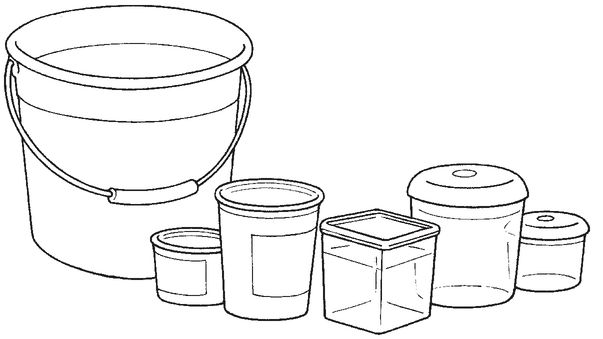
A variety of containers.
In Case of Small Water Emergencies
Between your tool kit and the supplies I’ve already described, you’re covered for a lot of different small breakdowns in the house. And here are two more things you shouldn’t neglect.
Plumbing leaks and backups are the most potentially damaging of the small home repair crises you will encounter day to day. Of course, you can always just shut off the household water at the main (see Chapter 4) and wait for the plumber. But a stopped sink or toilet, or a pinhole leak in a pipe, can be addressed with a couple of simple and inexpensive items.
A plunger, also known as a “plumber’s helper,” will help you clear many types of clogs in your waste water (drain) system; you can find out how to make these fixes in Chapter 10.
Plunger.

For tiny leaks in supply pipes, you can buy a package of do-it-yourself gasket material (cork or rubber is good), and a couple of adjustable hose clamps that fit your pipe (metal supply pipe is usually ½") to hold back the water until your plumber arrives. This fix is also covered in Chapter 10.
Pipe leak repair supplies.
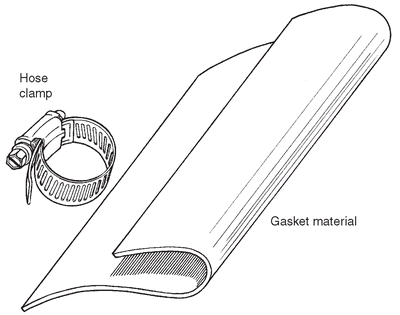
Storing Those Leftovers!
Whenever you or a pro do a home improvement project in your house, there’s usually material left over: extra tiles, extra paint or wallpaper, carpet scraps, or resilient flooring pieces.
In most houses, there never seems to be enough closets and cabinets to hold all our stuff; those DIY leftovers feel like just another pile of junk to deal with. So too often, the leftovers are thrown out or given away.
Even if you save that last half-roll of bedroom wallpaper, or the extra tile from the bathroom re-do, the tendency is to just throw the stuff in a box and put it anywhere out of the way where the box fits. The problem with that strategy is that you probably won’t find it when you need it!
If you look through this book, you’ll notice that many of the repair instructions call for leftover this-and-that. So do yourself a favor you’ll thank yourself for later. Buy some clear plastic storage containers and keep the leftover stuff in those. Label the containers with what’s in them and which room the leftovers came from. It’s an easy system, sure to save time, money, and trouble down the road.
In the case of leftover paint—great for touch-ups—you may not need the leftover half-gallon of the custom color in your living room ever again, but you might need a small amount. To have what you need to cover a future minor repair, save a half-pint or pint in a clean, airtight container; label it with the room, paint brand, color name, and color number. You’ll be glad you did. Custom colored paint is usually available in gallons only, a big expense and a big waste if you’re just doing touch-ups after a small repair.
Check with your local waste removal carrier (private or municipal), about the rules for paint and solvent disposal in your area. Usually, you cannot throw these substances away in the regular household trash pickup.
When you finally move on to your next place, you can give the leftovers to the next owners as a housewarming present. Having replacement parts is always handy!

Ounce of Prevention
Take care not to store certain liquids—like paint or solvents—in your home’s hot spots: near a heat source or in attics. Always check the original label; most DIY liquids belong in cool, dry places, with their lids tightly secured.
Closed containers for storing leftover materials.

The Least You Need to Know
• DIY supplies and materials deserve a dedicated place in your house. Find one that’s convenient for you and secure for all family members, including pets.
• A well-stocked supply closet includes at least one lubricant, a liquid adhesive and DIY tape, a selection of fasteners, and stuff for cover-ups and clean-ups.
• You’ll appreciate the value of a plunger and a pipe repair kit after your first night, weekend, or holiday plumbing emergency, when pros are hard to find.
• Leftover DIY stuff that you organize and save is destined to be very helpful later.
..................Content has been hidden....................
You can't read the all page of ebook, please click here login for view all page.
